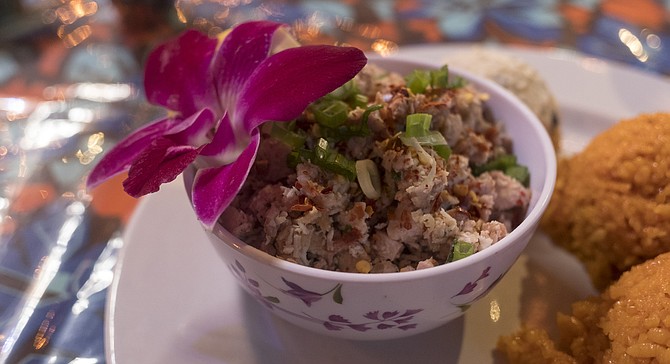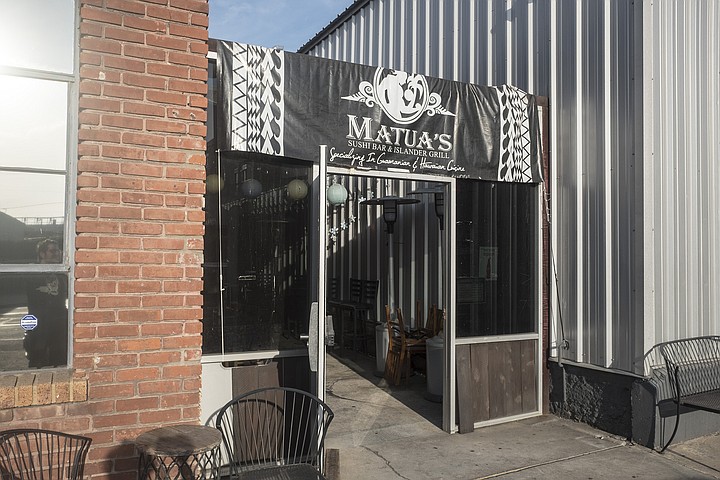 Facebook
Facebook
 X
X
 Instagram
Instagram
 TikTok
TikTok
 Youtube
Youtube

It looks like a pop up business. The front entry doesn't even have a roof, just a glassed in door frame leading to the alley between a brick warehouse and corrugated metal shed. The only sign is a printed vinyl banner draped over the top of the doorway: Matua's Sushi Bar & Islander Grill.
But that alley turns out to contain an overachieving dining patio. It shuts out the city with a fabric backyard shade structure, and hangs colorful clusters of round paper lanterns to soften the industrial setting. When I found the restaurant through a door at the back of the patio, I don't know what I expected, but it wasn't a subterranean dining room dominated by a circular island bar.

A circular sushi bar. This place has been the home base of sushi caterer, Sushi on a Roll, for years, and according to one of my servers, it still is, sharing the venue with Matua's. Still, this restaurant isn't a pop up; it moved a year ago from South Bay, where it had been open a couple of years. Its menu is huge.

And that includes sushi of its own, but there's a surplus of traditional Pacific island dishes from both Hawaii and Guam. Which sounds natural enough, until you consider geography. While Oahu sits about 2500 west of San Diego, Guam sits another 4000 miles east of that. Food-wise, the cultures have intermingled with a number of the same influences over the years, and happen to rank first and second in global spam consumption. But don't expect the Chamorro food of Guam to resemble Hawaiian.
The menu uses small icons to distinguish between Hawaiian and Guamanian dishes. Guamanian food restaurants number in the single digits in San Diego County, and I didn't want to miss the chance to try one.
Specifically, some chicken kelaguen. That seems to be the signature dish of many Guamanian restaurants, probably because it's the most distinctive. Grilled chicken gets chopped into tiny pieces, then cured with lemon juice and crushed chili peppers, and served cold.
It's BBQ chicken turned into ceviche, and finished with green onions and grated coconut. There's a lot going on here, and I'm glad to report nearly all of it is good. What stands out most is the smoke flavor of the chicken, given an edge with the tart, citrus-cooked tenderness of ceviche. A relatively mild spice from the red peppers gives way to a touch of coconut.
It's served with red rice, the color coming from achiote, which like the red peppers of the kelaguen reveals Guam's longtime access to Mexican ingredients as a fellow Spanish colony. In this way, kelaguen is an artifact of global history, a dish that could only have developed on a far-flung island on the western reaches of the Pacific. Just as important, it tastes good.


It looks like a pop up business. The front entry doesn't even have a roof, just a glassed in door frame leading to the alley between a brick warehouse and corrugated metal shed. The only sign is a printed vinyl banner draped over the top of the doorway: Matua's Sushi Bar & Islander Grill.
But that alley turns out to contain an overachieving dining patio. It shuts out the city with a fabric backyard shade structure, and hangs colorful clusters of round paper lanterns to soften the industrial setting. When I found the restaurant through a door at the back of the patio, I don't know what I expected, but it wasn't a subterranean dining room dominated by a circular island bar.

A circular sushi bar. This place has been the home base of sushi caterer, Sushi on a Roll, for years, and according to one of my servers, it still is, sharing the venue with Matua's. Still, this restaurant isn't a pop up; it moved a year ago from South Bay, where it had been open a couple of years. Its menu is huge.

And that includes sushi of its own, but there's a surplus of traditional Pacific island dishes from both Hawaii and Guam. Which sounds natural enough, until you consider geography. While Oahu sits about 2500 west of San Diego, Guam sits another 4000 miles east of that. Food-wise, the cultures have intermingled with a number of the same influences over the years, and happen to rank first and second in global spam consumption. But don't expect the Chamorro food of Guam to resemble Hawaiian.
The menu uses small icons to distinguish between Hawaiian and Guamanian dishes. Guamanian food restaurants number in the single digits in San Diego County, and I didn't want to miss the chance to try one.
Specifically, some chicken kelaguen. That seems to be the signature dish of many Guamanian restaurants, probably because it's the most distinctive. Grilled chicken gets chopped into tiny pieces, then cured with lemon juice and crushed chili peppers, and served cold.
It's BBQ chicken turned into ceviche, and finished with green onions and grated coconut. There's a lot going on here, and I'm glad to report nearly all of it is good. What stands out most is the smoke flavor of the chicken, given an edge with the tart, citrus-cooked tenderness of ceviche. A relatively mild spice from the red peppers gives way to a touch of coconut.
It's served with red rice, the color coming from achiote, which like the red peppers of the kelaguen reveals Guam's longtime access to Mexican ingredients as a fellow Spanish colony. In this way, kelaguen is an artifact of global history, a dish that could only have developed on a far-flung island on the western reaches of the Pacific. Just as important, it tastes good.
Comments